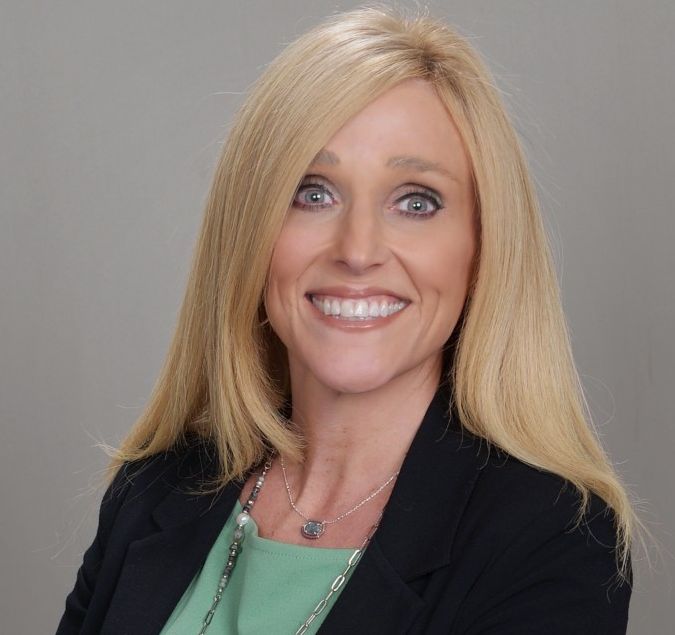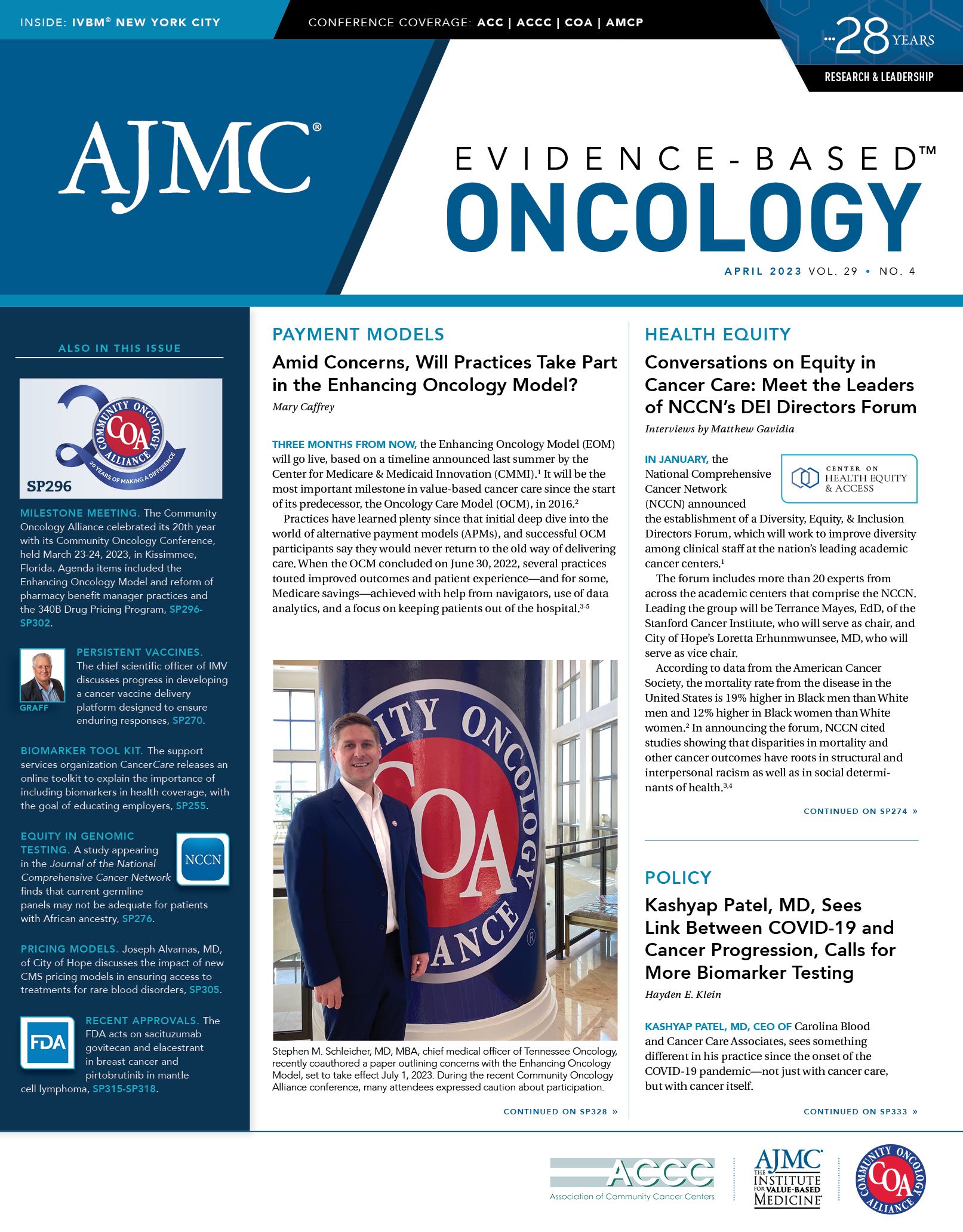- Center on Health Equity & Access
- Clinical
- Health Care Cost
- Health Care Delivery
- Insurance
- Policy
- Technology
- Value-Based Care
Health Equity Coverage: April 2023
Racial and Ethnic Disparities Persist in B-Cell ALL Survival in Children, Young Adults
Racial and ethnic disparities in survival outcomes persist among children and young adults with acute lymphocytic leukemia (ALL), despite overall improvements in survival outcomes in recent decades, according to a study published in The Lancet Haematology.
ALL is the most common pediatric cancer, and previous analyses have found that Black and Hispanic children with ALL who were treated 20 to 40 years ago had worse overall survival (OS) than other racial and ethnic groups at the time, the study authors noted. Children with low socioeconomic status backgrounds also had inferior OS compared with other children with ALL.
The new study encompassed 21,152 children, adolescents, and young adults with newly diagnosed ALL who were enrolled in 8 completed Children’s Oncology Group clinical trials for ALL in the United States, Canada, Australia, and New Zealand between January 2004 and December 2019. Patients were 30 years or younger and had race and ethnicity data available.
The main outcomes of interest were event-free survival (EFS) and OS across the following racial and ethnic groups: non-Hispanic White, Hispanic, non-Hispanic Black, non-Hispanic Asian, and non-Hispanic other. Multivariate regression models also examined potential contributors to disparities, including clinical and biological disease prognostic factors and insurance status.
The largest racial or ethnic group was the non-Hispanic White cohort (n = 13,872), followed by Hispanic patients (n = 4354), non-Hispanic Black patients (n = 1517), non-Hispanic Asian patients (n = 1071), and the non-Hispanic other group (n = 338). Although the entire cohort of trial participants included 24,979 patients, only the 21,152 included in the analysis had race and ethnicity data available.
In non-Hispanic White patients, 5-year EFS rate was 87.4% (95% CI, 86.7%-88.0%). Hispanic patients had a 5-year EFS rate of 82.8% and an HR of 1.37 (95% CI, 1.26-1.49). Non-Hispanic Black patients had a 5-year EFS rate of 81.8% and an HR of 1.45. Among non-Hispanic Asian patients, 5-year EFS was 88.1%, and non-Hispanic other patients had an EFS of 82.8%.
EFS in Hispanic patients was impacted significantly by prognosticators and insurance status. With those aspects factored in, HR decreased from 1.37 to 1.11. In non-Hispanic Black patients, HR decreased from 1.45 to 1.32 when prognosticators and insurance status were considered.
There were also differences in OS between the cohorts. Non-Hispanic Asian patients had a 5-year OS of 93.6%, non-Hispanic White patients had an OS of 93.3%, Hispanic patients 89.9%, non-Hispanic Black patients 89.7%, and the non-Hispanic other cohort had an OS of 88.9%. The disparities in OS were more substantial than in EFS—non-Hispanic other patients had an HR of 1.43 for EFS vs 1.74 for OS, for example.
Notably, the disparities seen in the cohort were only significant in patients with B-cell ALL, not in patients with T-cell ALL. This was true in both EFS and OS. But overall, the findings suggest there are persistent disparities in ALL outcomes among children, adolescents, and young adults across various racial and ethnic groups. The differences were not entirely explained by disease prognosticators or insurance status.
“One notable mechanism for disparities in health outcomes relates to differences in access to and quality of care across race and ethnicity, which have been shown in general and in subspecialty pediatrics and adult oncology, but are understudied in childhood leukemia,” the authors wrote.
“Although treated in clinical trials at centers offering specialized care, there might still have been differences in standardized diagnostic tests, time to treatment initiation, provision of family education, time spent with providers, and supportive care.”
Although the large population in the study and the availability of clinical data are strengths, limitations included missing data that led to 15% of the overall cohort being excluded from the analysis. Outcomes were similar in excluded patients, but the authors noted that the distribution of race and ethnicity among included vs excluded patients could be different. Due to barriers to trial enrollment, the study cohort may not be representative of the real-world population, they added.
Reference
Gupta S, Dai Y, Chen Z, et al. Racial and ethnic disparities in childhood and young adult acute lymphocytic leukaemia: secondary analyses of eight Children’s Oncology Group cohort trials. Lancet Haematol. 2023;10(2):e129-e141. doi:10.1016/S2352-3026(22)00371-4
SPOTLIGHT: Telehealth Involves More Than Making a Phone Call, Says Oncology Consultants’ Wagner
Sabo-Wagner

Health equity initiatives that search for the right telehealth modality are never-ending, according to Susan Sabo-Wagner, MSN, RN, OCN, executive director of clinical strategy at Oncology Consultants in Houston, Texas. Not every technology is a good fit for every person, Sabo-Wagner told Evidence-Based Oncology (EBO) during an interview that took place in New York, New York, at the February 8 session of the Institute for Value-Based Medicine®. This interview is lightly edited for clarity.
EBO: How can community oncologists and health care providers facilitate telehealth access for those whose care may be hindered by social determinants of health?
Sabo-Wagner: The best thing all providers can do is to continue to search and seek the right technology, because not every technology fits every person. And what we’ve known through health equity initiatives is that not every person out there, in rural areas and otherwise, has access to the internet; they don’t have access to good phone technology. So, [we’re] continuing that search for the right product, then continuing to have access in those areas.
If telehealth is not something that is as good or even an opportunity in an area, to even have days—even if it’s a half day or a whole day in an area—that really could be serviced by a provider physically being there is [helpful]. The search for the right telehealth modality is never-ending, and as soon as we find something that isn’t just a phone call, we’ll be onto something for real.
National Primary Care Scorecard Highlights Need for Funding, Workforce Development, and Care Access
A recent national report, The Health of US Primary Care: A Baseline Scorecard Tracking Support for High-Quality Primary Care, reveals a lack of financing, a shrinking workforce, gaps in care access, and almost no federal funding for research in the primary care space.1
The scorecard, published February 21, 2023, was created following a call to action in the 2021 National Academies of Sciences, Engineering, and Medicine (NASEM) report on implementation of primary care in the United States. The new report is the first national primary care scorecard and was funded by the Milbank Memorial Fund and The Physicians Foundation. The Milbank Memorial Fund, based in New York City, works to improve population health and health equity, while The Physicians Foundation advances the work of practicing physicians by supporting practice sustainability and the provider-patient relationship.
“We cannot underestimate the critical role primary care plays in our health care system, from improving patient outcomes to enhancing access to quality care for everyone,” Ripley Hollister, MD, a board member of The Physicians Foundation and family medicine physician, said in a statement.2
“This first benchmark report provides necessary recommendations to help address the mounting challenges that primary care physicians [PCPs] are facing. We look forward to seeing the report published annually to ensure we embrace opportunities to improve primary care and provide a better future for America’s health.”
The authors addressed several key areas where there is room for improvement based on data from the past decade: systemic investment in primary care, the PCP workforce, access to care, physician training, and federal research funding.
Lack of Investment Minimizes Progress
“I think this scorecard is extraordinarily important, because we need to have a synthesis and we need the data, and we need to have a baseline in order to track which direction we’re headed,” said Jennifer Lee, MD, chief medical officer of the Alliance of Community Health Plans, during a virtual panel discussion following the release. “Unfortunately, the scorecard reveals that we are headed in the wrong direction when it comes to investing in primary care.”
The report found that less than 6.5% of total health spending was dedicated to primary care between 2010 and 2020 in the United States. However, nations in the Organisation for Economic Co-operation and Development dedicated 7.8% of health care spending to primary care on average in 2016, per the initial NASEM report.
Although primary care spending can be defined differently by various stakeholders, the report considers it “the proportion of total health care expenditures being spent on outpatient and office-based visits to primary care clinicians.” Medicare primary care spending has also decreased consistently since 2014, with a low of 4.2% in 2020, according to the report.
Additionally, payment models for physician reimbursement are often unsupportive of teams rooted in whole-person care. Hybrid models with elements of fee-for-service and capitation reimbursement that compensate the entire primary care team are ideal but can be administratively complex, the authors wrote.
As Workforce Shrinks, Gaps in Care Access Persist
The report highlighted a drop in the proportion of physicians practicing primary care in recent years. In 2010, 1 in 3 physicians practiced primary care, but only 1 in 5 medical residents between 2012 and 2020 were practicing primary care 2 years later. This indicates a need to strengthen the pipeline to primary care practice, the authors wrote.
In 2010, 23% of US adults reported using the emergency department as a source of care and not having a PCP. This statistic climbed to 27% in 2020. The proportion of clinicians performing primary care also varies by state, and primary care access overall is lacking in underserved communities, the authors noted. In underserved areas, there were approximately 55.8 PCPs per 100,000 individuals vs 79.7 per 100,000 in areas not considered medically underserved in 2020.
“Although efforts by organizations such as community health centers play a central role in providing access to patients in medically underserved areas, the data demonstrate that much of the country still falls short in meeting these critical access needs,” the authors wrote.
Need for Training in Community Settings Exists
Most primary care occurs in the community setting, and the NASEM report emphasized a need for training to reflect this. Some states expose all physicians to medically underserved areas or rural settings, but in some states only 5.9% of physician residents will experience these settings in training, the scorecard report found.
The distribution of physician residents also does not align with the geographic areas where physicians are entering primary care, the authors noted. “The mismatch between training opportunities and PCP supply signals that graduate medical education funding is not set up to support the growth of primary care but instead encourages subspecialty fields,” they wrote. Graduate medical education funding is most often allocated to sponsor institutions, although primary care is more often performed in community settings.
All Stakeholders Need Access to Uniform Data
Family medicine departments received just above 0.2% of the National Institutes of Health research funding. Although there are other primary care specialties, family medicine was chosen as the measurement because it has the most US health care encounters, the authors noted.
During the panel discussion, Yalda Jabbarpour, MD, lead author of the scorecard and director of the Robert Graham Center, also highlighted a lack of uniform data available for research purposes.
“If we don’t have uniform data that [are] easily accessible to all stakeholders who want to research this either on the state or health system or national level, it’s going to be hard to keep the nation accountable to moving towards implementing high-quality primary care,” Jabbarpour said. “As a research team, that was what we noticed right away…and we looked at these data in so many different ways, using so many different data sources. Maybe we didn’t get to perfection, but we got to ‘good enough’—but it would be nice to not have to spend all those resources to do that.”
Overall, the baseline scorecard emphasizes a need for research and investment into primary care, as well as consistent reporting to improve care access, workforce development, and the PCP pipeline in the United States going forward.
“Our health care system is wildly out of balance and in critical need of reform,” Christopher Koller, president of the Milbank Memorial Fund, said in a statement. “We can do better, and this scorecard can serve as an essential tool for policymakers and other stakeholders to pursue policies that will increase investments in high-quality primary care in every community.”
References
1. Jabbarpour Y, Petterson S, Jetty A, Byun H. The health of US primary care: a baseline scorecard tracking support for high-quality primary care. Milbank Memorial Fund. February 22, 2023. Accessed February 23, 2023. https://www.milbank.org/publications/health-of-us-primary-care-a-baseline-scorecard/v-research-there-are-few-federal-funding-opportunities-for-primary-care-research-with-only-0-2-of-national-institutes-of-health-funding-allocated-to-primary-care/
2. Underinvestment, workforce shortages, and lack of research funding threaten the future of America’s primary care. News release. Milbank Memorial Fund. February 22, 2023. Accessed February 23, 2023. https://www.milbank.org/news/first-national-primary-care-scorecard-reveals-a-health-care-sector-in-peril/
Sashi Naidu, MD: NOLA Initiative Is Helping Overcome Fragmented Oncology Care
Naidu

At Carolina Blood and Cancer Care Associates (CBCCA), based in Rock Hill, South Carolina, the No One Left Alone (NOLA) initiative is working to break down cancer health disparities among patients by addressing the social determinants of health that may be preventing equitable access to care.
Sashi Naidu, MD, is director of research for CBCCA and for the NOLA initiative, which was implemented in January 2021. He spoke with Evidence-Based Oncology (EBO) before presenting results for NOLA during a session of the Institute for Value-Based Medicine® held February 8, 2023, in New York, New York.
EBO: Can you discuss the NOLA initiative from Carolina Blood and Cancer Care Associates?
Naidu: NOLA was conceived by our need at our practice. There are a lot of foundations and opportunities for patient access, but it’s often a fragmented process. So, the purpose of NOLA was to bring that process in-house, where the patients can feel comfortable that the physicians who are their treating doctors are taking care of this aspect of their health care, which often can be a very big challenge—even sometimes more than the clinical aspects of their cancer care.
EBO: What is the status of patient assistance initiatives for oral cancer drugs within NOLA?
Naidu: We picked up oral financial assistance initiatives just like the intravenous drugs. It’s a seamless process. As with many community oncology practices, there is an oral dispensary in-house. It is just a very easy transition to add oral financial assistance to our intravenous drug financial assistance. So, there [have] not been any major problems there.

